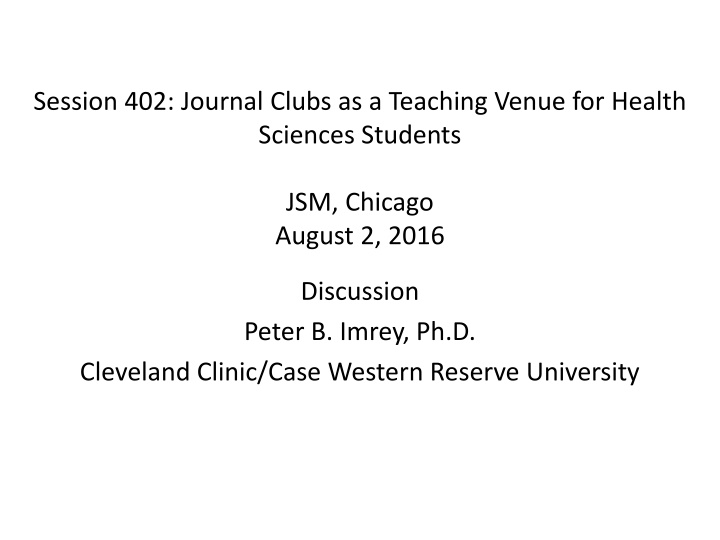
How Journal Clubs Benefit Health Sciences Students: Insight from JSM Session 402
Discover the valuable role of journal clubs in educating health sciences students, reinforcing conceptual understanding, and fostering interdisciplinary collaboration. Gain insights into effective teaching strategies and the limitations of journal clubs in achieving specific learning objectives.
Download Presentation

Please find below an Image/Link to download the presentation.
The content on the website is provided AS IS for your information and personal use only. It may not be sold, licensed, or shared on other websites without obtaining consent from the author. If you encounter any issues during the download, it is possible that the publisher has removed the file from their server.
You are allowed to download the files provided on this website for personal or commercial use, subject to the condition that they are used lawfully. All files are the property of their respective owners.
The content on the website is provided AS IS for your information and personal use only. It may not be sold, licensed, or shared on other websites without obtaining consent from the author.
E N D
Presentation Transcript
Session 402: Journal Clubs as a Teaching Venue for Health Sciences Students JSM, Chicago August 2, 2016 Discussion Peter B. Imrey, Ph.D. Cleveland Clinic/Case Western Reserve University
Speaker JC Participants Goal Simon Medical residents Teach biostatistics & critical appraisal through EBM Healy I Certificate in Applied Biostatistics trainees. Review, reinforce, teach, and extend biostatistical concepts and methods. Healy II Clinical/translational sciences (CTC) trainees Illustrate course concepts, address student-generated issues. Healy III MGH clinical department JC attendees. Adjunctive biostatistical perspective to content-oriented JC. Interprofessional training component Chapman Medical oncology, medical/bioscience, biostatistics students Transdisciplinary, scientifically integrated finishing school for stat ed program. Pfenning Epidemiology grad students Identify, exemplify common pitfalls in drawing and communicating conclusions from scientific studies. Beyler Statisticians and other Quants. Disseminate statistical knowledge, support statistical methods research, encourage mentoring, support professional development.
Dimensions of the journal club space Goal: content-specific didactic, illustrative reinforcement, contextual/integrative Presentation/discussion mode Roles of methods & subject-matter faculty Roles and preparation of students Design, paper, and topic selection Time allocation Target style Inducements, formal and/or social
Journal clubs are good for engaging students reinforcing, contextualizing, broadening a concept conveying the structure of research methods parsing the structure of research reports modeling integration of statistical concepts into science imparting an organized approach to critical appraisal identifying clear examples of poor statistical thinking building understanding of concepts, episodically
Journal clubs are good for socialization to interdisciplinary collaboration countering the fear of statistics, mathematics, and statisticians developing student responsibility for leadership and participation development of student presentation skills. small group teaching
Journal clubs are less good for teaching to mastery of specific objectives: fixed topic list possible but hard lecture > 5 mins or more interactive didactics > 10 mins Introducing concepts requiring extended development, hence, de novo teaching the meaning, esp. detailed technical bases, of most design and analytic concepts technical discussions predicated on shared background or serious preparation beyond the article
Journal clubs are less good for fully independent student discussion of research methods and research validity large groups (tragedy of the commons) objective student evaluation
E = any Exposure D = any Disease or other health-related outcome
Causal Prognostic E E D D Causal or Prognostic D E Statistical Association E and D Chance Selection Bias Measurement Bias Confounding Bias
Causal Prognostic E E D D Causal or Prognostic D E Statistical Association E and D Chance Selection Bias Measurement Bias Confounding Bias
My journal clubs Faculty select papers for design, preferably after solicitation from students Occasional ringers/plants Student discussion leader (DL) paper proposer. Zero to intensive pre-session DL orientation Can be most rewarding part Aggressive faculty intervention Terminological precision emphasized Student passivity discouraged Frankness, debate encouraged Fairly detailed feedback
My journal clubs Contextualization, role modeling of scientific work, debunking of ritualized statistical nonsense Struggle, actively, with what was done, why, and whether it makes sense. Think, actively, even if just briefly, the way each of us must, daily. Open the door to intellectual growth in clinical research methodology.
Thanks to Speakers serious teaching work, sensible choices, nice talks Audience, for your attention.
